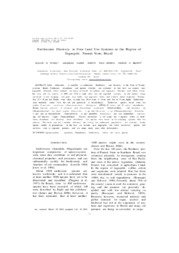Earthworm diversity in four land use systems in the region of Jaguapitã, Paraná State, Brazil.
Earthworm diversity in four land use systems in the region of Jaguapitã, Paraná State, Brazil.
Author(s): NUNES, D. H.; PASINI, A.; BENITO, N. P.; BROWN, G. G.
Summary: Little infonnation is available on earthwonn distribution and diversity in the State of Paraná, southern Brazil, Earthwonn abundanee and species diversity was evaluated in four land use systems near [aguapítã, (Paraná); where pastures are being eonverted to soybean and sugarcane. Samples were taken during the rainy and dry seasons of 2004 and 2005 in eight sites: two old degraded pastures, an old pasture being eonverted to row eropping, two grain erop fields, two sugareane fields and a native forest fragmento Twentyfive 25 x 25 em soil bloeks were taken at eaeh síte, 20 of them to 10 em and five to 30 em depth. Earthwonns were manually sorted from the soil and preserved in fonnaldehyde. Earthwonn species found were: the exotics Pontoscolex corethrurus (Glossoscolecidae), Dichogaster affinis, D. bolaui and D. saliens (Acanthodrí- Iidae), Eukerria saltensis, E. eiseniana and Ocnerodrilus occidentalis (Ocnerodrilídae), and Amynthas sp. (Megascolecidae): the native species Glossoscolex n. sp. and Fimoscolex n. sp. (Glossoscolecidae), Belladrilus n. sp.l and an unidentifiable Oenerodrilidae n, sp.l (probably Belladrílus); and two unidentified Eukerria spp. (of unknown origin) (Oenerodrilidae). Pasture eonversion to row erops had a negative effect on earthwonn abundanee and diversity: fewer individuais and species were found in the eropping systems than the pastures. The forest was not a suitable referenee site, having low earthworm populations and diversity. Exotie species tended to predominate in the land use systems near [aguapítã, but native earthworm species still survived, even in degraded pastures and row erops, many years after deforestation.
Publication year: 2006
Types of publication: Journal article
Unit: Embrapa Forestry
Keywords: Agroecossistema, Biodiversidade, Espécie Nativa, Espécie exótica, Minhoca, Oligochaeta
Observation
Some of Embrapa's publications are published as ePub files. To read them, use or download one of the following free software options to your computer or mobile device. Android: Google Play Books; IOS: iBooks; Windows and Linux: Calibre.
Access other publications
Access the Agricultural Research Database (BDPA) to consult Embrapa's full library collection and records.
Visit Embrapa Bookstore to purchase books and other publications sold by Embrapa.

